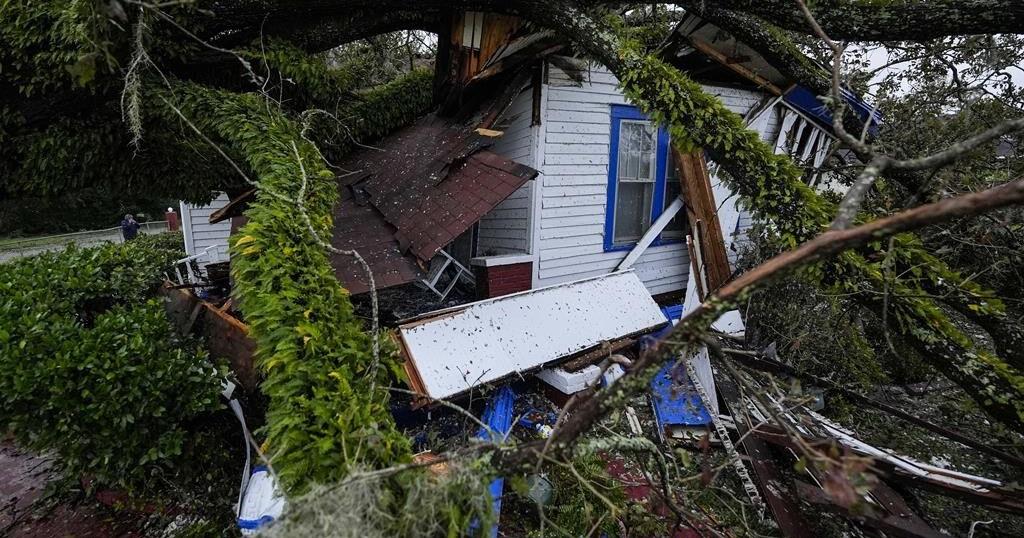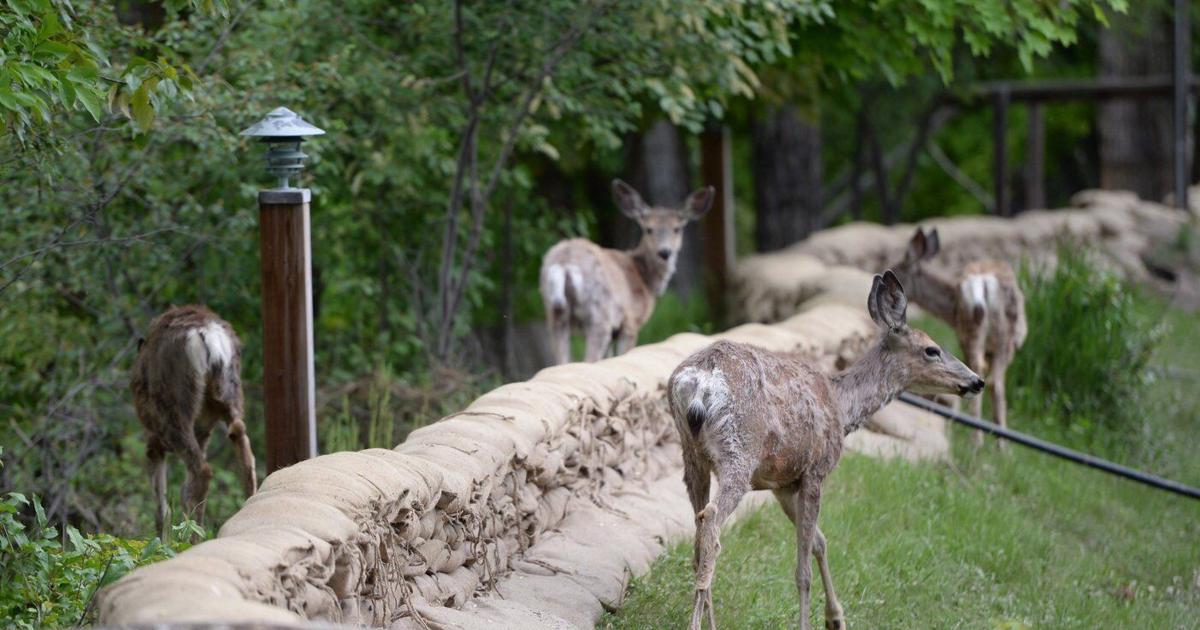PERRY, Fla. (AP) — Massive rains from powerful Hurricane Helene left people stranded, without shelter and awaiting rescue Saturday, as the cleanup began from a tempest that killed at least 64 people, caused widespread destruction across the U.S. Southeast and left millions without power.
“I’ve never seen so many people homeless as what I have right now,” said Janalea England, of Steinhatchee, Florida, a small river town along the state’s rural Big Bend, as she turned her commercial fish market into a storm donation site for friends and neighbors, many of whom couldn’t get insurance on their homes.
Helene blew ashore in Florida’s Big Bend region as a Category 4 hurricane late Thursday with winds of 140 mph (225 kph).
From there, it quickly moved through Georgia, where Gov. Brian Kemp said Saturday that it “looks like a bomb went off” after viewing splintered homes and debris-covered highways from the air. Weakened, Helene then soaked the Carolinas and Tennessee with torrential rains, sending creeks and rivers over their banks and straining dams.
Western North Carolina was isolated because of landslides and flooding that forced the closure of Interstate 40 and other roads. All those closures delayed the start of the East Tennessee State University football game against The Citadel because the Buccaneers’ drive to Charleston, South Carolina, took 16 hours.
There have been hundreds of water rescues, none more dramatic than in rural Unicoi County in East Tennessee, where dozens of patients and staff were plucked by helicopter from a hospital rooftop Friday. And the rescues continued into the following day in Buncombe County, North Carolina, where part of Asheville was under water.
“To say this caught us off guard would be an understatement,” said Quentin Miller, the county sheriff.
Asheville resident Mario Moraga said it’s “heartbreaking” to see the damage in the Biltmore Village neighborhood and neighbors have been going house to house to check on each other and offer support.
“There’s no cell service here. There’s no electricity,” he said.
While there have been deaths in the county, Emergency Services Director Van Taylor Jones said he wasn’t ready to report specifics, partially because downed cell towers hindered efforts to contact next of kin.
Relatives put out desperate pleas for help on Facebook. Among those waiting for news was Francine Cavanaugh, whose sister told her she was going to check on guests at a vacation cabin as the storm began hitting Asheville. Cavanaugh, who lives in Atlanta, hasn’t been able to reach her since then.
“I think that people are just completely stuck,” she said.
The storm, now a post-tropical cyclone, was expected to hover over the Tennessee Valley on Saturday and Sunday, the National Hurricane Center said.
‘Catastrophic’ flooding
It unleashed the worst flooding in a century in North Carolina, where Gov. Roy Cooper described it as “catastrophic” as search and rescue teams from 19 states and the federal government came to help. One community, Spruce Pine, was doused with over 2 feet (0.6 meters) of rain from Tuesday through Saturday.
And in Atlanta, 11.12 inches (28.24 centimeters) of rain fell over 48 hours, the most the city has seen over two days since record keeping began in 1878.
President Joe Biden said Saturday that Helene’s devastation has been “overwhelming” and pledged to send help. He also approved a disaster declaration for North Carolina, making federal funding available for affected individuals.
Helene is the deadliest tropical cyclone for South Carolina since Hurricane Hugo killed 35 people when it came ashore just north of Charleston in 1989. Deaths also have been reported in Florida, Georgia, North Carolina and Virginia.
Moody’s Analytics said it expects $15 billion to $26 billion in property damage. AccuWeather’s preliminary estimate of the total damage and economic loss from Helene in the U.S. is between $95 billion and $110 billion.
Climate change has exacerbated conditions that allow such storms to thrive, rapidly intensifying in warming waters and turning into powerful cyclones sometimes in a matter of hours.
Evacuations and overtopped dams
Evacuations began before the storm hit and continued as lakes overtopped dams, including one in North Carolina that forms a lake featured in the movie “Dirty Dancing.” Helicopters were used to rescue some people from flooded homes.
And in Newport, Tennessee, Jonah Wark waited so long to evacuate that a boat had to come to the rescue. “Definitely a scary moment,” Wark said.
After touring the damage by helicopter, a stunned U.S. Rep. Diana Harshbarger said, “Who would have thought a hurricane would do this much damage in East Tennessee?”
Among the 11 confirmed deaths in Florida were nine people who drowned in their homes in a mandatory evacuation area on the Gulf Coast in Pinellas County, where St. Petersburg is located, Sheriff Bob Gualtieri said.
None of the victims were from Taylor County, which is where the storm made landfall. It came ashore near the mouth of the Aucilla River, about 20 miles (30 kilometers) northwest of where Hurricane Idalia hit last year at nearly the same ferocity.
“If you had told me there was going to be 15 feet to 18 feet of storm surge, even with the best efforts, I would have assumed we would have had multiple fatalities,” Florida Gov. Ron DeSantis said Saturday.
Taylor County is in Florida’s Big Bend, went years without taking a direct hit from a hurricane. But after Idalia and two other storms in a little over a year, the area is beginning to feel like a hurricane superhighway.
“It’s bringing everybody to reality about what this is now with disasters,” said John Berg, 76, a resident of Steinhatchee, a small fishing town and weekend getaway.
Timmy Futch of Horseshoe Beach stayed put for the hurricane before driving to high ground when the water reached his house. many homes in the town, which his grandfather helped found, were reduced to piles of lumber.
“We watched our town get tore to pieces,” Futch said.
The aftermath
About 60 miles (100 kilometers) to the north, cars lined up before sunrise Saturday at a free food distribution site in Perry, Florida, amid widespread power outages.
“We’re making it one day at a time,” said Sierra Land, who lost everything in her fridge, as she arrived at the site with her 5- and 10-year-old sons and her grandmother.
Thousands of utility crew workers descended upon Florida in advance of the hurricane, and by Saturday power was restored to more than 1.9 million homes and businesses. But hundreds of thousands remain without electricity there and in Georgia.
Chris Stallings, director of the Georgia Emergency Management and Homeland Security Agency, said crews were focused on opening routes to hospitals and making sure supplies can be delivered to damaged communities.
Helene was the eighth named storm of the Atlantic hurricane season, which began June 1. The National Oceanic and Atmospheric Administration has predicted an above-average season this year because of record-warm ocean temperatures.
___
Payne reported from Perry, and Hollingsworth reported from Kansas City, Missouri. Associated Press journalists Seth Borenstein in New York; Travis Loller in Nashville, Tennessee; Jeff Amy in Atlanta; Susan Haigh in Hartford, Connecticut; and Freida Frisaro in Fort Lauderdale, Florida, contributed.

























